Changing the Fantasmatic Scene - Kaja Silverman |
| "Ship" is a metonymy for the sailor
with whom Emma sleeps in the Borges' story, chosen by her because he is
scheduled to sail out the next day on the Nordstjarnan. "Figurehead",
one of the most resonant words in Katz's film, is in part a synecdoche for
the ship, and thus a further metonymy for the sailor; it emphasizes his
surrogate status, the fact that he merely stands in for the father (Emma
deliberately passes over a younger for an older sailor). However, it refers
as well to the factory owner, who is also a surrogate, and whose slippage
out of his symbolic role at a critical moment in the narrative facilitates
Emma's emergence from the Oedipal drama. The phrase "a time when history liquidates the masters", which will be repeated later in the film, is the first of a number of political "slogans" by means of which Emma represents the projected murder to herself (others include the lines "Could she be a terrorist?" and "Is this America? Yes. Is this democracy? No!" as well as newsreel footage of striking workers). These slogans have a magical, incantatory quality about them, and are clearly signifiers for another scene. What that scene might be is indicated a moment later, by the reference to Saturn, primordial and barbaric father. (It is thus evident from the very beginning of the film that Emma inverts the relationship between the political and the familial – that she subordinates the former to the latter, privileging the microcosm over the macrocosm. Splits suggests that female subjectivity as we now know it is always predicted on such an inversion.) |
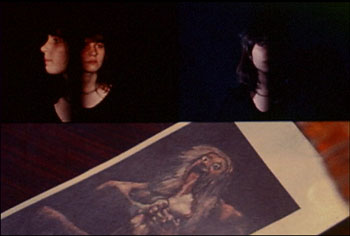 |
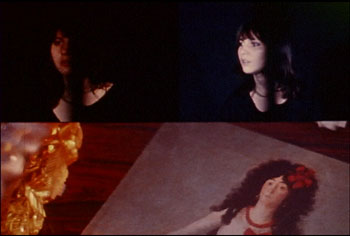 |
| The political discourse is
linked to the familial through the intermediary phrase "a bubbling
substance", which not only literalizes the metaphor "liquidates",
but intersects at a key point with the legend of Saturn – at the point,
that is, where having swallowed all of his children but one, he is fed a
poisoned drink by his wife and surviving son. This action is a repetition
of Saturn's ealier destruction of his own father, and it anticipates a series
of subsequent parricides and child-killing. There will be a number of additional
references to Saturn, both in this section of the film and in the third
one. Each will function to evoke the Oedipal fantasmatic. The prologue is followed by Emma's return home from the fabric mill, and her discovery of the "letter from far away" in her mailbox - events which are both narrated by the two voices, and depicted in the lower half of the frame. The envelope with its foreign stamp, shown in extreme close-up, induces in Emma the acute vertigo which will accent her subjectivity until the end of the film. One of the voices describes this condition, which would seem to be characterized both by a disintegration of preconscious defences and logic, and by a drastically increased vulnerability to unconscious imperatives: |
| I climbed the stairs to my room. My first impression was of a weak feeling in my stomach and knees. I wished that it already were the next day. The plan had to come to me completely developed in one flash. There were no considerations to consider, nor were there alternative choices to be made. I realised that I wasn't thinking. I was obsessed, but if I could have been asked, I wouldn't have been able to say what my obsession was. |
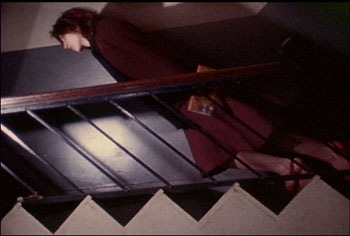 |
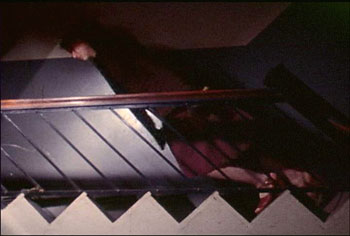 |
| This confession is accompanied by
six tilted shots of Emma climbing the stairs to her apartment, shots which
are distinguishable from each other only be slight variations in framing
and lighting. The repetition of an action which is always broken off before
completion, and the acuteness of the angle from which it is shown, create
the impression of what will later be called "a time outside of time";
Emma seems almost to be sleepwalking. The closing of the door of Emma's room marks the beginning of the performance proper, although the arrival of the letter must be understood as the impetus behind it. Within this claustral space (designated "The Armory" by one of the titles) the fantasmatic assumes the proportions outlined by Laplanche and Pontalis: |
| a. Even when they can be summed up in a single
sentence, phantasies are still scripts (scenarios) of organised scenes which
are capable of dramatisation – usually in a visual form. b. The subject is invariably present in these scenes ... c. It is not an object that the subject imagines and aims at, but rather a sequence in which the subject has his own part to play and in which permutations of roles and attributions are possible ... d. In so far as desire is articulated in this way through phantasy, phantasy is also the locus of defensive operations: it facilitates the most primative of defence processes, such as the turning round upon the subject's own self, reversal into the opposite, negation and projection. |
| Not only does the elaboration of Emma's desires
take a visual and sequential form, but it undergoes a striking reversal.
The libidinal mise-en-scene is articulated by means of a slow pan across the objects on Emma's desk, a shot which not only describes a certain sequence within which the subject has her own part to play, but which speaks to the possibility of a reversal. Immediately prior to that pan there is an isolated shot of a postcard reproduction of Goya's painting of Saturn Devouring His Son. The child's sexual identity is not apparent from the postcard – his father holds him with his back to us, and he has already lost his head and right arm. In the next shot, shifting its angle slightly, the camera again hovers over this lethal image before moving to the right to disclose the next prayer in the drama: Goya's Duchess of Alba. In this particular view of that painting, again in the form of a postcard reproduction, only the Duchess's head: right arm and upper torso are visible; the rest of her body is cropped by the frameline. In other words, precisely those parts of the victim's anatomy which are missing in the adjacent postcard are featured here, suggesting a perfect "match" between the devoured child and the Duchess of Alba – implying, that is, that they are two inscriptions of the same thing. Desires which cannot be overtly expressed through the Duchess have apparently been displaced onto the distant scene of Saturn and his son. That suspicion is confirmed in a later, overhead shot of the desk, in which both postcards can be seen in their entirety. The Duchess's outstretched arm seems to be pointing, with surreptitious pleasure, to the bloody spectacle at her right. She herself is coyly bound in ribbons, beads and bracelets, and a toy poodle at her feet wears a red ribbon on one of his legs, reiterating in miniature the bondage motif. The Duchess is pre-eminently "civilised", an impression which is compounded by the savage connotations of the adjacent portrait. What might be called her "pet-like" qualities –the combination of docility and refinement– recall Freud's remarks about the "niceness" of the masochist. 20 What emerges from the first part of the pan is perhaps the most heavily overdetermined of the "female" variants of the Oedipal fantasmatic - that variant which is codified in "A Child is Being Beaten." 21 We recall that the scenario in question has three stages, the second of which is so culturally unspeakable that it is seldom remembered. In stage 1 someone is beating a child; in stage 2 the subject is being beaten by the father; and in stage 3 a boy or group of boys is being beaten by a figure distinct from, but reminiscent of, the father. |
The second version of the
paradigm marks the emergence of female sexuality, both in its turning
around of the aggressivity apparent in the earlier stage onto the subject
herself, and in its isolation of the father as the instrument of a pleasurable
pain. It is itself already the product of a displacement (or to be more
precise, a regression) from the genital to the anal phase; the taboo wish
to sleep with the father seeks disguised fulfillment through a fantasy
in which the subject submits to the father's force in another guise, and
in another part of her body than the forbidden one. However, the little
girl's desires undergo a further, more radical displacement in the third
stage, in which a boy or group of boys stands in for her, and a surrogate
for the father. (Freud adds that other forms of punishment of humiliation
can take the place in the fantasy of an actual beating.) In Splits the child is being eaten, but the scenario otherwise conforms with startling precision to the third stage of the masochistic model outlined in Freud's essay. Although the child seems to be a boy, it is actually a girl, and it is her father who administers the punishment which becomes, through a regression to pre-genital sexuality (here the oral phase) a form of erotic gratification. Finally, although the subject seems only to be watching this spectacle, she is in fact inside it – both in the "acceptable" guise of the Duchess of Alba, to whom she bears a striking resemblence (the only feature of Emma's appearance about which we are ever certain is her hair, which like Goya's aristocrat is full, brown and curly), and in the much more taboo, and hence repressed guise of the (b)eaten child. However, the pan continues, isolating objects suggestive of a change of scene (a miniature globe, turned towards China, a postcard photograph of a locomotive), arriving finally at the "letter from far away". The camera moves slowly across the surface of the envelope, a movement which can only be read as the psychic registration of an event –the paternal suicide– which radically shifts the terms of the fantasmatic. |
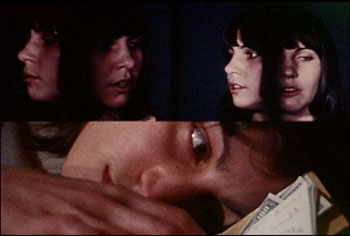 |
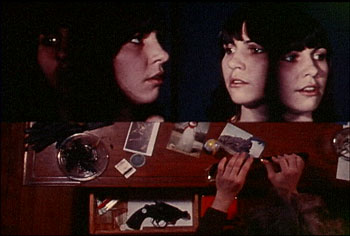 |